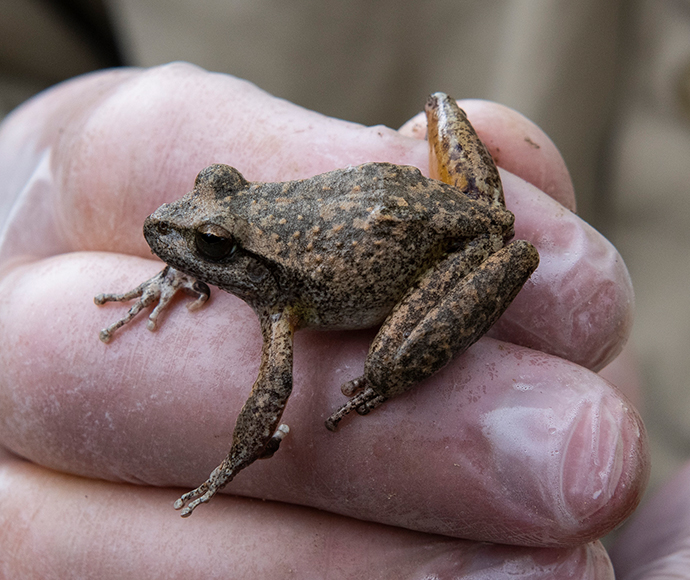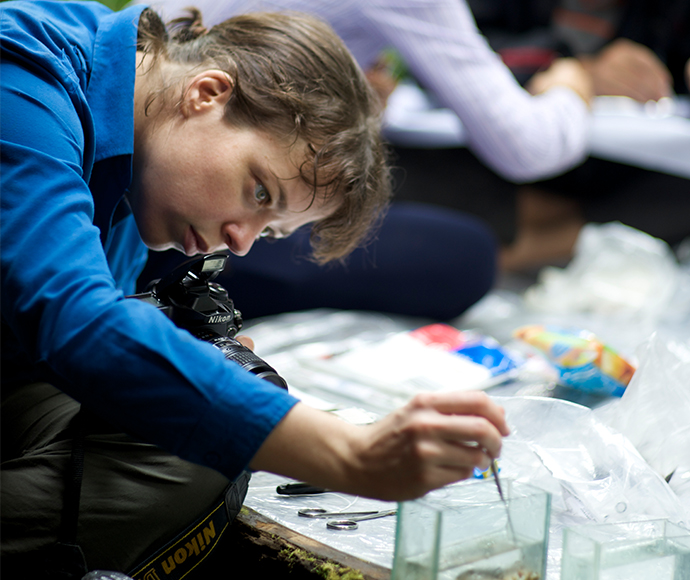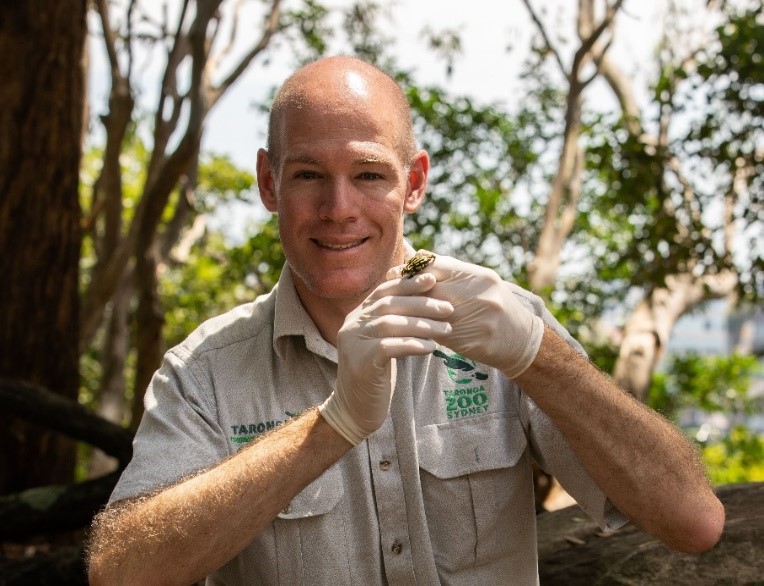Nearly 30 species of frogs are under threat in NSW, putting the survival of these ecological powerhouses at risk. That's why these 4 frog experts are going above and beyond to secure a future for 3 stream-associated frogs in western NSW.

There are more than 240 known species of frog in Australia, many of which are facing population decline. The decrease and disappearance of many frog species here and around the world has been due in large part to the amphibian chytrid fungus disease.
The fungus has also affected the populations of three threatened stream-associated frogs found in western NSW – the Booroolong frog (Litoria booroolongensis), yellow-spotted bell frog (Litoria castanea) and spotted tree-frog (Litoria spenceri).
The fungus, combined with loss of stream habitat, sedimentation, weed invasion, changes to stream hydrology, and the use of herbicides and pesticides near streams, has led to their status as threatened.
All hands on deck
Threatened species officers with the Saving our Species program are working in partnership with scientists, private landholders, State Forests, private forestry, Landcare, Local Land Services and National Parks and Wildlife Service on projects to improve conservation outcomes for these three threatened stream-associated frogs.
Stream-associated frogs are a group of frogs that rely on streams for breeding and in Australia most of their populations are in decline.
The focus of conservation effort includes captive breeding and translocation, protecting and rehabilitating areas of habitat, weed and erosion control and taxonomic research.

David Coote – Conservation ecology and the yellow-spotted bell frog
The spectacular critically endangered yellow-spotted bell frog was thought to be extinct in the wild for over thirty years, until it was rediscovered in a creek in the Yass area in 2009.
David Coote, a Senior Threatened Species Officer for the Department of Planning Industry and Environment manages threatened species conservation projects in north western NSW.
One of these projects sees him coordinate progressive releases of captive bred yellow-spotted bell frogs back to the wild.
"Just getting to the point where Taronga can successfully breed the species in captivity was a win and it couldn't have happened without a lot of hard work from the project team," says David. "Concurrently we've been working with the Local Land Services and land managers to protect and improve riparian habitat to help re-establish this species in the wild".
David says the outlook for yellow-spotted bell frog is hard to predict.
"Not all reintroductions are successful, however the collaboration and dedication from purposeful partnerships and working together for the conservation of this species has increased the chances of its survival."
You can watch a video about saving the yellow-spotted bell frog here.

Dr Jodi Rowley – Taxonomy, conservation and Booroolong frogs
The endangered Booroolong frog is a medium sized tree frog, that lives in permanent rocky streams. It was once widespread, from the Queensland to Victorian border, but has disappeared from more than half of its range over recent decades.
Dr. Jodi Rowley is the Curator, Amphibian and Reptile Conservation Biology at the Australian Museum Research Institute and University of New South Wales, Sydney.
Jodi rediscovered Booroolong frogs in the New England Tablelands after they hadn't been seen there for over 40 years.
She is undertaking collaborative research to determine the degree of genetic, morphological and acoustic separation between populations of Booroolong frog, particularly between the northern tablelands populations and those further south. Identifying just how different populations of Booroolong frog are from each other, and if there might even be two species of Booroolong frog, is important for their conservation.
"Surprisingly, we don't yet know how many species of frog we have in Australia," Jodi says. "When we look closer, many frog species we thought we knew are actually more than one species, they just look incredibly similar! Investigating the diversity within threatened frog species may therefore have huge implications for their conservation."
Jodi works with frogs because "they have the greatest level of undocumented diversity of any terrestrial vertebrate group, perform irreplaceable functions in many ecosystems and are being lost at an unprecedented rate."

Dr David Hunter and the spotted tree frog
The critically endangered spotted tree frog is extremely rare, only occurring in Kosciuszko National Park and one other small 'at risk' population in the central highlands of Victoria.
Dr. David Hunter, a Senior Threatened Species Officer for the Department of Planning Industry and Environment, works on several frog conservation programs and led a team that captured the last remaining individuals of the spotted tree frog in Kosciuszko National Park in 2001.
The surviving frogs were sent to the Amphibian Research Centre where they bred in captivity, but the first attempt to re-establish them back in Kosciuszko failed when the released frogs were wiped out (again) by the fungus.
Discovering a warmer site with higher temperatures that didn't favour the fungus, David led the successful translocation program that resulted in in the spotted tree frog returning to Kosciuszko National Park after it was thought to be extinct in the wild for more than 15 years.
David says the outlook for the spotted tree-frog is still unknown but that finding evidence of juvenile frogs as a result of breeding in the new location is promising.
"The NSW government's threatened frog programs, over the past 25 years, have demonstrated that by obtaining adequate knowledge and developing the right partnerships with land managers, we can work towards ensuring the future of these spectacular creatures," David says.

Michael McFadden – Ex-situ conservation
Michael McFadden is the Supervisor of the Herpetofauna division at Taronga Zoo where he oversees the Zoo's collection of reptiles and amphibians. This includes the management of ex-situ conservation programs for several critically endangered species, like the yellow-spotted bell frog and Booroolong frog.
His work focuses mostly on reintroduction biology and developing techniques to improve captive breeding and rearing success in threatened Australian frogs.
"Ex-situ conservation is important in amphibian conservation because there are a number of species that have declined to such low levels that they would unfortunately disappear before we have the opportunity to effectively manage the threats in the wild," Michael explains.
"Establishing insurance colonies allows us to buy time for the species and be able to produce large numbers of offspring to re-establish populations in the wild.
"The outlook for threatened stream-dependent frogs in NSW is yet to be determined. On the one hand we have some excellent conservation work being undertaken to protect these species and secure them into the future. On the other, we are still working against a disease that we are learning more about, in addition to the impacts of the changing climate, where we have seen the devastation of severe drought and bushfire over the last year. However, with the current collaborations and partnerships in place, we are in a good position to give some of these species the best chance to bounce back".
Looking ahead
Recovery strategies for these stream-dependent frogs build on decades of research and conservation management as well as long-standing partnerships between different agencies and individuals.
These pioneers in frog research and ecology hope that the continued implementation of collaborative strategies informed by research and monitoring will improve the long-term prospects of these species. It is increasingly important in a climate-changed world to build the resilience of these frogs and their habitat to drought and stream-drying.
"Although recovery strategies focus on single species, the benefits to the hundreds of other species big and small that also depend on streams – including us - is pretty clear," says David Coote.






